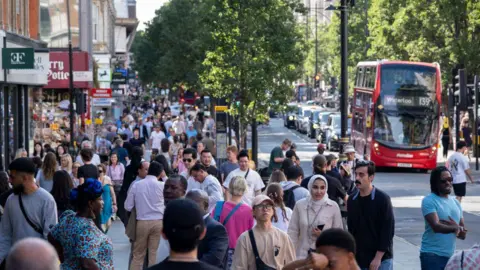In a substantial shift for the United Kingdom’s immigration landscape, net migration was reported to have decreased drastically in 2024, nearly halving to a total of 431,000 individuals. This marked a poignant reduction when compared to the previous year’s figure of 860,000, as detailed by the Office for National Statistics (ONS). The drop represents the largest numerical decline on record, a significant event that reflects broader economic and policy shifts within the nation.
The ONS’ findings highlight several contributing factors to this significant decline in net migration. Central to this change were reductions in the number of individuals arriving in the UK for work and study purposes. This trend stems from various policy changes implemented by the preceding Conservative government, which have greatly influenced visa restrictions and immigration conditions. Additionally, a considerable number of foreign nationals who had initially come to the UK on student visas during the relaxed Covid-19 restrictions have commenced their exit from the country, further compounding the reduction in net migration figures.
Moreover, the latest estimates from the ONS demonstrate that there was a notable decrease in the number of dependents accompanying individuals who were entering on work and study visas. This aligns with the government’s objectives to tighten immigration controls, demonstrating a concerted effort to reshape the demographic makeup of migrants entering the country.
In the context of historical comparisons, this decline in net migration stands out significantly. The preceding record for the largest annual decrease was witnessed during the Covid-19 pandemic, when net migration fell from 184,000 in December 2019 to just 93,000 in the year ending December 2020. However, the recent numbers reflect a more prolonged and formal shift in policy and social dynamics, suggesting a multifaceted approach to handling immigration amid aims for fiscal responsibility and securing welfare systems.
The narrative surrounding these figures emphasizes that many students who had been drawn to the UK are now leaving, influenced by recent changes which limit the ability of international students to bring family members along. This policy was instigated under the oversight of former Home Secretary James Cleverly and was aimed explicitly at curtailing immigration influx among student demographics.
A report issued by the Home Office coincided with the ONS findings and noted that, while the number of asylum seekers residing in taxpayer-funded accommodations like hotels has decreased — from 38,079 in December 2024 to 32,345 in March 2025 — it remains significantly higher than before the last general elections. This statistic reflects ongoing challenges the government faces as it attempts to manage the influx of asylum seekers while processing their claims more rapidly.
Home Secretary Yvette Cooper emphasized that there had been a notable drop in net migration, claiming a decrease of approximately 300,000 since the last election. In her comments, Cooper pointed to the increasing efficiency in returning failed asylum seekers and addressing issues related to illegal working, portraying a government committed to pushing forward with measures to bring those numbers down even further.
Conversely, other political figures, particularly from the Conservative Party, have sought to take credit for the decline in migration figures while acknowledging that more still needs to be done to achieve lower numbers. Chris Philp, the shadow home secretary, attributed the fall to prior government actions but insisted that further reductions are essential.
Independent analysts from Oxford University’s Migration Observatory noted that the decline was notably influenced by exceptionally high migration figures in preceding years. Dr. Madeleine Sumption indicated that the fluctuations in the current immigration patterns may not markedly impact the UK economy, as the segments of the migrant population impacting the numbers are neither the highest skilled nor the most vulnerable.
In conclusion, the figures reported for 2024 convey a critical juncture for UK immigration policy. The significant drop in net migration reflects a convergence of policy changes and global circumstances shaped by the pandemic and its aftermath. As these statistics continue to resonate through political discourse, they will likely play a pivotal role in shaping future discussions on immigration and the socio-economic strategies that accompany them.



